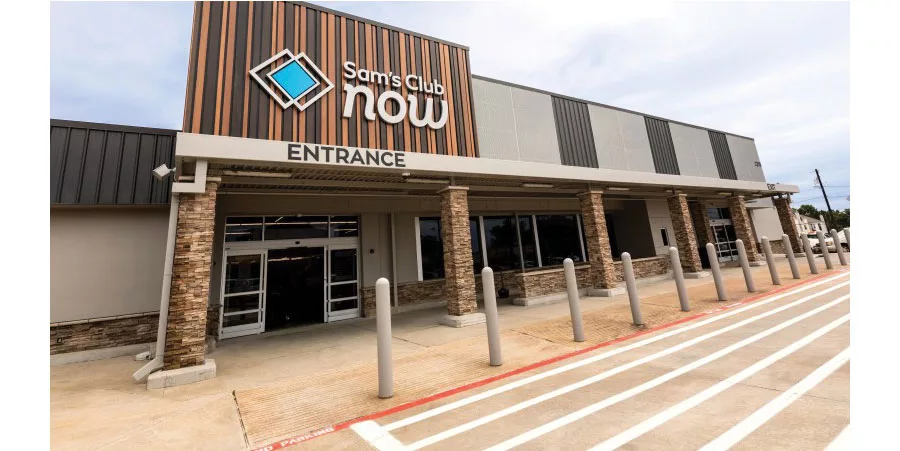Club store channel performance holds steady
Stores find new ways to enhance shopping experience

Sam’s Club is set to open a new club store in Dallas dubbed Sam’s Club Now. Sam’s Club Now offers shopping through the store’s app, where shoppers can make eShopping lists, find a product’s exact location, and even see how items are sourced through augmented reality. (Image courtesy of Walmart Inc.)
Amid the time in retail where eCommerce seems to reign supreme, club stores actually are holding their own and showing revenue growth. Club stores are among the non-traditional retail formats that have performed well in recent years, outpacing performance of traditional full-service supermarkets, says Jon Hauptman, senior director at Winston-Salem, N.C.-based Inmar Analytics.
“According to Inmar’s ‘2019 Future of Food Retailing’ report, in 2018 club stores grew in dollar sales by 3.3 percent versus 2017,” Hauptman explains. “And they enjoyed steady annual growth in the 2 to 3 percent range over the several years leading up to 2018 as well.”
Hauptman attributes club store’s steady growth to the following:
- Focus on value — providing high-quality food products at low, market-leading prices;
- Enhancing grocery offerings by selling a wide range of new and interesting products and flavors, especially in their store-brand assortment;
- And a strong emphasis on interesting and often indulgent seasonal and holiday “in-and-out” items, adding to the treasure hunt atmosphere of these stores.
Los Angeles-based IBISWorld also notes the steady performance of the club-store channel. “[I]ndustry revenue has increased at an annualized rate of 1.4 percent to $505.6 billion over the five years [from 2014] to 2019,” according to its June “Warehouse Clubs & Supercenters in the US” report. “Industry revenue is expected to rise 2.7 percent in 2019 alone, in line with a 2.2 percent increase in per capita disposable income that same year.”
Due to the low-cost, high-value products offered by warehouse clubs and supercenters, the industry typically performs well regardless of the macroeconomic climate, IBISWorld’s report states. However, when businesses and consumers have deeper pockets, they likely will spend more at club stores and supercenters, it adds.
Inmar’s Hauptman also highlights disposable income as a key driver. “Club stores have disproportionate appeal to consumers who have adequate disposable income to stock up and purchase larger sizes, i.e., consumers at the middle to upper-middle income levels,” he explains. “Even affluent households like to be ‘smart shoppers’ and save money where they can. Club stores help them to do so in an interesting, engaging treasure hunt environment.”
Realizing growth opportunities
The club-store channel largely is dominated by three key players: Sam’s Club, owned by Bentonville, Ark.-based Walmart Inc.; Costco Wholesale Corp., Seattle; and BJ’s Wholesale Club Inc., Westborough, Mass. According to IBISWorld’s report, Walmart, including its supercenters, and Sam’s Clubs, comprise 70.7 percent of the total industry market share. Costco and BJ’s are No. 2 and No. 3 in the wholesale club industry with market shares of 19.3 percent and 2.6 percent, respectively.
Although Walmart and Sam’s Club command the lion’s share of the industry, Costco recently has become the dominant player in the club channel, Inmar’s Hauptman says. “[Costco’s] been growing at an average of almost 6 percent for the past five years with rates significantly higher than that over the past two years,” he says. “They were able to raise their membership fees from last year and are already back on track with renewals at rates as high as they were prior to the increase. Their buying power and solid financial footing will allow them to absorb cost increases longer than their grocery competitors, thereby putting them in a position to capture even more business.”
Even with its steady growth, one area where Costco has fallen behind the competition is shopper technology, Hauptman says. Sam’s Club is taking a leadership position with its “scan-and-go” cashier-less mobile app checking offering, he explains.
Sam’s Club also is implementing aisle kiosks that are allowing shoppers to browse and purchase a wider assortment of items that can be displayed in a single club store and then delivered to their homes, Hauptman adds.
Another example of Sam’s Club leading in the technology aspect is its new store format. In June, the company announced it will be opening a new club store in Dallas dubbed Sam’s Club Now, an epicenter of innovation and interactive experiences, it says. “Since launching our Scan & Go app two years ago, we’ve seen its popularity continue to increase,” the company said in a statement at the time of the announcement. “[W]e’re taking Scan & Go and making it the foundation of the new Sam’s Club Now app, which all members will use to shop here.”
The Sam’s Club Now app offers smart shopping lists, wayfinding and navigation, augmented reality features and one-hour grocery pickup. Sam’s Club Now is set to open its doors by the end of this month.
Going forward, as eCommerce continues to grow, it also can be a strong growth driver for club stores. In fact, eCommerce sales at both Costco and Sam’s Club increased more than 20 percent in 2018 vs. 2017, Inmar’s Hauptman says. For example, club stores can expand their online assortments to include more seasonal products and smaller items such as beauty and food products, he adds. BI
Looking for a reprint of this article?
From high-res PDFs to custom plaques, order your copy today!






